John Fisher Cocken, 1808-1880
by Brian Stevenson
last updated November, 2018
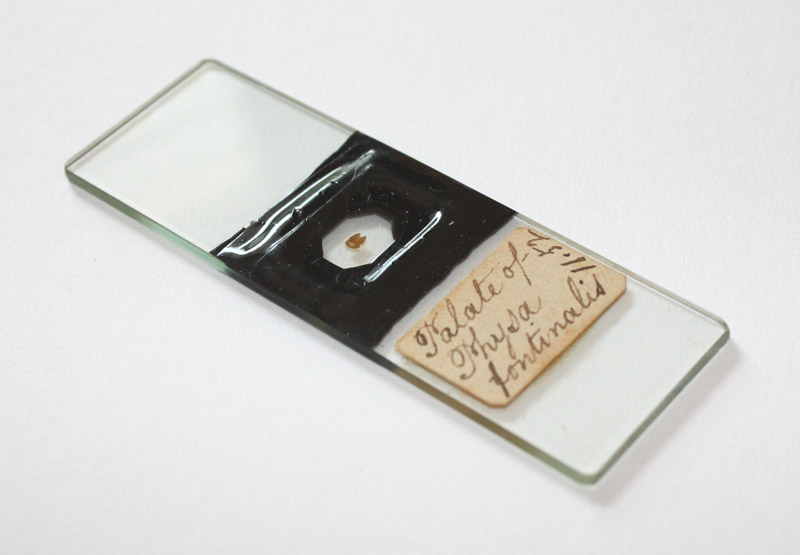
Figure 1.
A typical microscope slide attributable to John F. Cocken. He was a renowned amateur mounter of snail “palates” (i.e., radula, the rasp-like feeding organ). Cocken was also well-known for his mounts of acari (mites). A contemporary described Cocken’s slides as being finished like this example, with a thick coating of black asphalt to seal the specimen.
Collectors of early microscope slides will be familiar with slides that are sealed with abundant, shiny black asphalt, and usually contain a snail radula (labeled as “palate” or “tongue”) or an array of male and female acari (mites) (Figures 1, 2 and 3). The labels are handwritten, and lack a name or address. The many different types of specimens, and minimal known repetition, suggest that the maker produced them in order to study details, rather than for mass sales to the public. A hypothesis of that time suggested that relationships between mollusks could be ascertained from comparisons of their radulae. Consistent with that notion, our slide-maker often wrote the down numbers of “teeth” contained on radulae (Figure 4).
Many of the slides were produced (or acquired) during the early 1850s, as indicated by a number of slides that bear handwritten dates between 1851-54. Most of this mounter’s preparations do not carry dates, however. It is possible that the dates were added by a second person, who acquired a large number of these slides from their maker.
A number of the slides were sold by Smith, Beck & Beck and by Joseph Amadio circa 1863-66 (Figures 5 and 6). Slides with Smith, Beck & Beck labels bear the address of 31 Cornhill, their address from mid-1863 until the company reorganized as R. & J. Beck in 1866. Amadio’s 1864 catalogue advertised a large number of slides whose descriptions match those of this mounter (Figure 6). Intriguingly, the slides offered by Amadio bore random numbers, suggesting that this was a one-time offering of a private collection. The availability of large numbers of these slides from Amadio and Smith, Beck & Beck suggest that something critical occurred around 1863 that led to the slides’ dispersal.
The identity of the slides’ maker has been lost to time. Some collectors have given the maker the nicknames “Palate Man” and “Acari Man”, in light of the most frequent subjects.
Recently, collector Richard Courtiour acquired a Victorian-era cabinet of slides, in a condition that suggested that it had not been disturbed for many decades. One of the drawers had labels reading “Tongues & Palates” and “J.F. Cocken” (Figure 7). None of the other drawers bear a person’s name. The cabinet contained a substantial number of “tongue” and “palate” slides by our mounter. Additionally, a slide bearing a label with our mounter’s handwriting was donated to the Royal Microscopical Society by J.F. Cocken (Figure 8). Investigation of J.F. Cocken indicate that he was very likely “Palate / Acari Man”. A summary of the evidence is presented below, and details of his life and works are provided following Figure 8.
 Cocken’s burial headstone is inscribed “microscopist and naturalist” (Figure 16).
Cocken’s burial headstone is inscribed “microscopist and naturalist” (Figure 16).
 Cocken donated large numbers of snail and acari slides to the Quekett Microscopical Club.
Cocken donated large numbers of snail and acari slides to the Quekett Microscopical Club.
 Samuel Pickworth Woodward’s 1851 Manual of the Mollusca includes acknowledgements of Cocken’s slides, such as “… the lingual membrane of T. haliotides, from a preparation by Fisher Cocken, Esq., of Botesdale”, and "P. concortus, a minute species, has above 6,000 teeth (Cocken)". The same book also notes that "Mr. Warington and Mr. Fisher Cocken recommend glycerine (which may be obtained at Price’s, of Vauxhall) as the best medium for microscopic objects; the glass covers are cemented on with hatter’s-varnish (shell-lac dissolved in spirits of wine), and painted over afterwards with asphalt dissolved in turpentine, such as the varnish-makers supply". (“Warington” was probably Robert Warington (1807-1867) who, for various reasons, is unlikely to be our slide-maker).
Samuel Pickworth Woodward’s 1851 Manual of the Mollusca includes acknowledgements of Cocken’s slides, such as “… the lingual membrane of T. haliotides, from a preparation by Fisher Cocken, Esq., of Botesdale”, and "P. concortus, a minute species, has above 6,000 teeth (Cocken)". The same book also notes that "Mr. Warington and Mr. Fisher Cocken recommend glycerine (which may be obtained at Price’s, of Vauxhall) as the best medium for microscopic objects; the glass covers are cemented on with hatter’s-varnish (shell-lac dissolved in spirits of wine), and painted over afterwards with asphalt dissolved in turpentine, such as the varnish-makers supply". (“Warington” was probably Robert Warington (1807-1867) who, for various reasons, is unlikely to be our slide-maker).
 John William Taylor’s 1907 Monograph of the Land & Freshwater Mollusca of the British Isles stated, “Mr. Cocken, who prepared the radula from which the engraving was made, correctly indicated the species under Lamarck's name, T. haliotoides”.
John William Taylor’s 1907 Monograph of the Land & Freshwater Mollusca of the British Isles stated, “Mr. Cocken, who prepared the radula from which the engraving was made, correctly indicated the species under Lamarck's name, T. haliotoides”.
 An 1894 talk to the Royal Microscopical Society by A.D. Michaels on parasites included, "Closely allied to the Itch-Mites are the harmless Bird-Parasites, the Analgesine, familiar to all of you from the preparations of the late Mr. Cocken".
An 1894 talk to the Royal Microscopical Society by A.D. Michaels on parasites included, "Closely allied to the Itch-Mites are the harmless Bird-Parasites, the Analgesine, familiar to all of you from the preparations of the late Mr. Cocken".
 John Edward Gray (1800-1875) was an authority on many biological topics, including mollusks. It was Gray who forwarded the hypothesis that radulae held the key to mollusk phylogeny. His publications included On the Teeth on the Tongues of Mollusca. Following an 1853 article “On the teeth of the pneumonobranchiate Mollusca”, Gray wrote, "I intended, in my paper on the Teeth of Pulmonata in the last Number, to have observed, that the illustrations of that paper were kindly drawn by Mr. S.P. Woodward from the well-mounted specimens of Messrs. Cocken and Wilton. The examination of the large series of mounted specimens belonging to these gentlemen and other microscopists, has been very useful to me in these researches, as showing the uniformity and permanence of the characters afforded by the teeth, and sometimes of drawing my attention to peculiarities of form, and inducing me to examine the teeth of the animal they were said to be taken from".
John Edward Gray (1800-1875) was an authority on many biological topics, including mollusks. It was Gray who forwarded the hypothesis that radulae held the key to mollusk phylogeny. His publications included On the Teeth on the Tongues of Mollusca. Following an 1853 article “On the teeth of the pneumonobranchiate Mollusca”, Gray wrote, "I intended, in my paper on the Teeth of Pulmonata in the last Number, to have observed, that the illustrations of that paper were kindly drawn by Mr. S.P. Woodward from the well-mounted specimens of Messrs. Cocken and Wilton. The examination of the large series of mounted specimens belonging to these gentlemen and other microscopists, has been very useful to me in these researches, as showing the uniformity and permanence of the characters afforded by the teeth, and sometimes of drawing my attention to peculiarities of form, and inducing me to examine the teeth of the animal they were said to be taken from".
 The death of Samuel Pickworth Woodward (1821-1865) followed a long illness. An obituary reported that, “for the last twenty years of his life, he suffered from chronic asthma, which eventually became so distressing as to awaken the sympathies of all, and caused many to marvel at the energy he displayed in research and conversation during intervals of release from pain. An attack of acute bronchitis which occasioned the rupture of an artery in the lungs, was the immediate cause of his death, at Herne Bay, (whither he had gone in the hope of benefit to his health)”. Noting that Woodward investigated slides of snail radulae that were prepared by J.F. Cocken, both for his own works and for those of Gray, it is likely that Woodward possessed a good number of Cocken’s mounts. Woodward’s decline and move to Herne Bay coincided with the sale of our mounter’s slides by Amadio and Smith, Beck & Beck, suggesting that he may have been the source of those slides.
The death of Samuel Pickworth Woodward (1821-1865) followed a long illness. An obituary reported that, “for the last twenty years of his life, he suffered from chronic asthma, which eventually became so distressing as to awaken the sympathies of all, and caused many to marvel at the energy he displayed in research and conversation during intervals of release from pain. An attack of acute bronchitis which occasioned the rupture of an artery in the lungs, was the immediate cause of his death, at Herne Bay, (whither he had gone in the hope of benefit to his health)”. Noting that Woodward investigated slides of snail radulae that were prepared by J.F. Cocken, both for his own works and for those of Gray, it is likely that Woodward possessed a good number of Cocken’s mounts. Woodward’s decline and move to Herne Bay coincided with the sale of our mounter’s slides by Amadio and Smith, Beck & Beck, suggesting that he may have been the source of those slides.
 The large number of “Palate Man / Acari Man”’s slides have been found in a Victorian-era cabinet drawer labeled “J.F. Cocken” (Figure 7).
The large number of “Palate Man / Acari Man”’s slides have been found in a Victorian-era cabinet drawer labeled “J.F. Cocken” (Figure 7).
 A slide donated to the Royal Microscopical Society by J.F. Cocken bears a label with “Palate Man / Acari Man” ’s handwriting (Figure 8).
A slide donated to the Royal Microscopical Society by J.F. Cocken bears a label with “Palate Man / Acari Man” ’s handwriting (Figure 8).
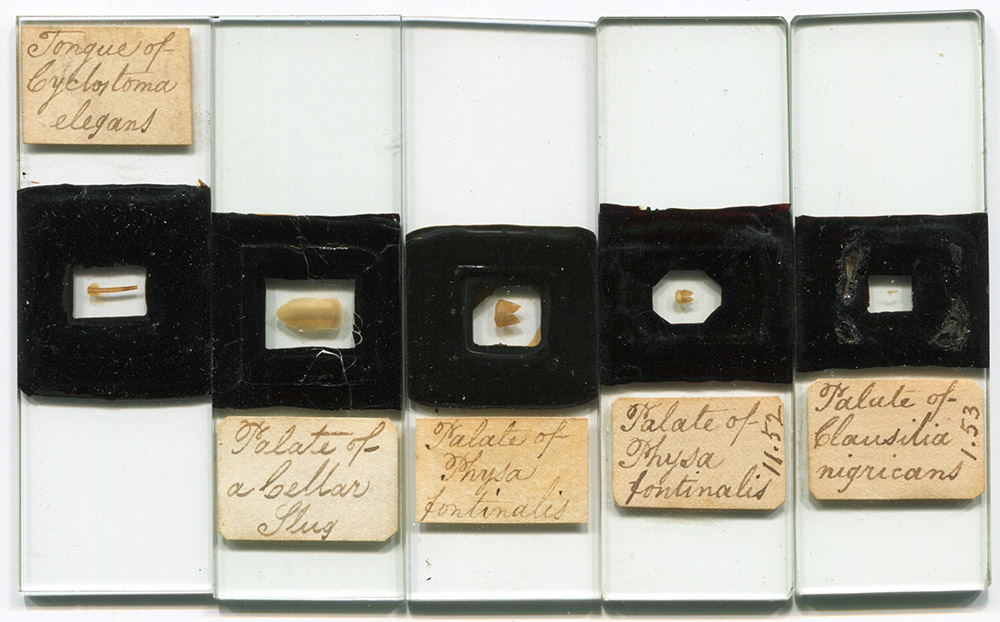
Figure 2.
Microscope slides of snail radulae (“tongues” or “palates”).
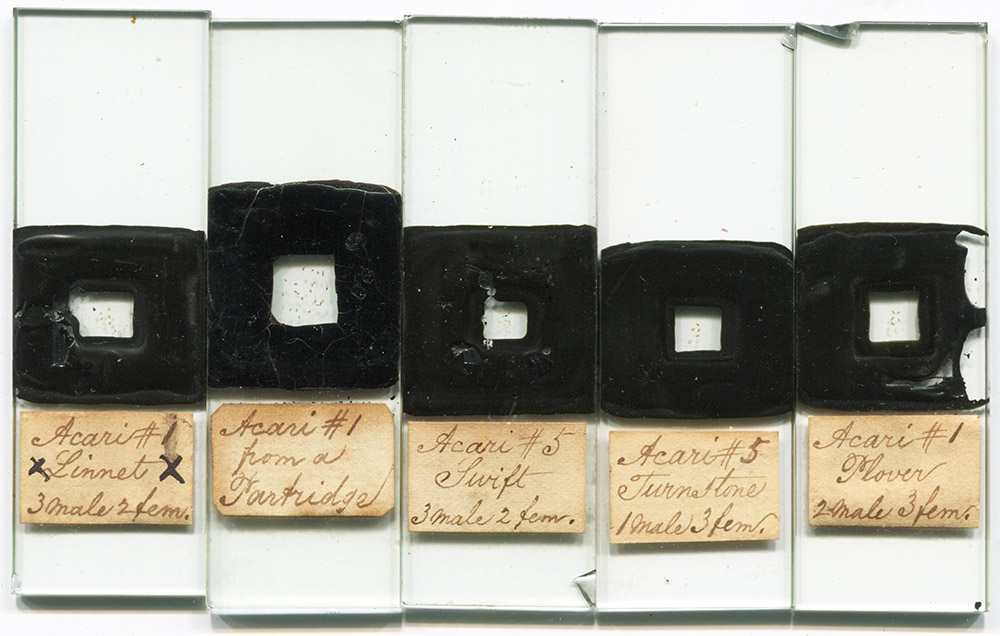
Figure 3.
Microscope slides of acari (mites). These are almost always mites that are specific to birds, and most contain examples of both males and females.
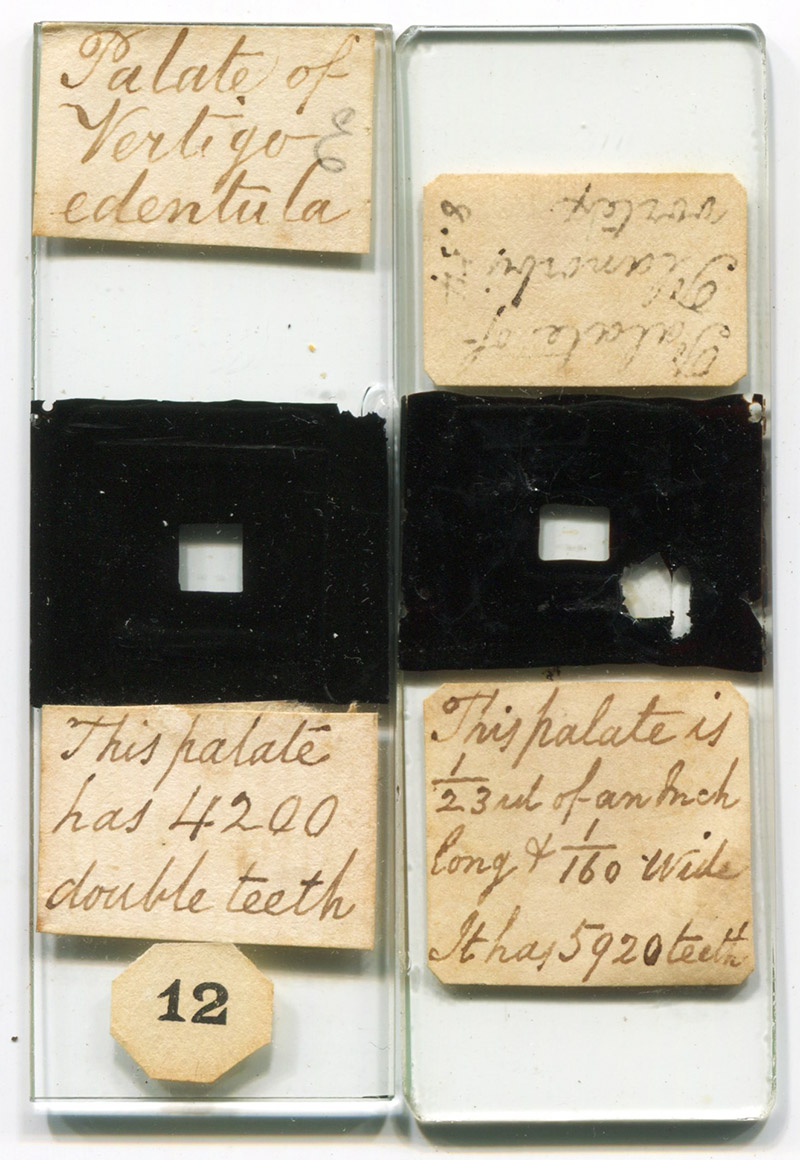
Figure 4.
Slides of “palates”, of which the maker counted the number of “teeth”. At the time, such details were thought to provide important insights on relationships between snail species.
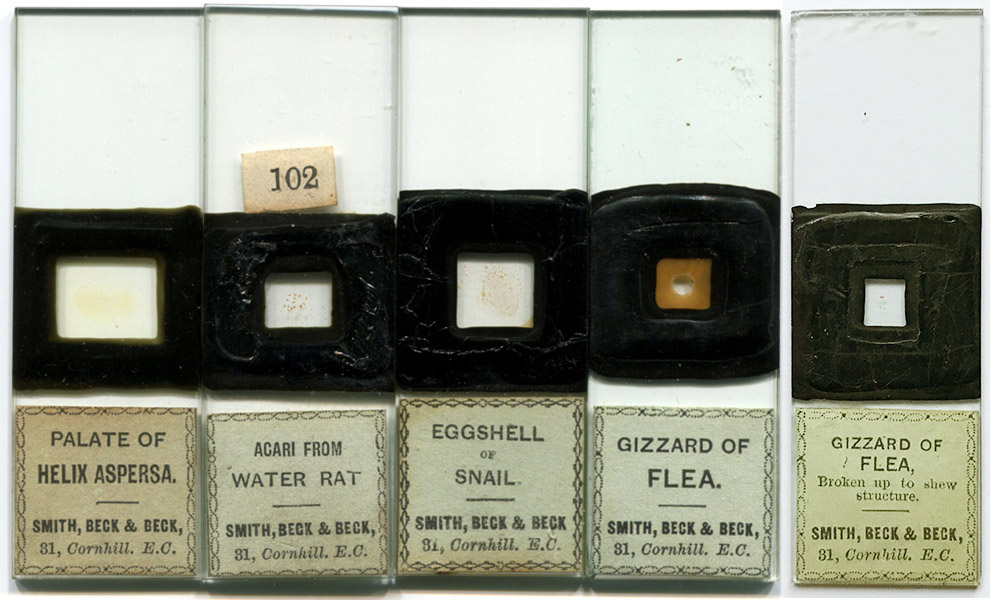
Figure 5.
Some slides that were labeled for sale by Smith, Beck & Beck. That microscope company was located at 31 Cornhill, London, from mid-1863 until James Smith’s resignation in 1866, whereupon the name was changed to R. & J. Beck. The Smith and Beck companies regularly replaced or covered over slide-maker’s labels with their own custom-printed labels.
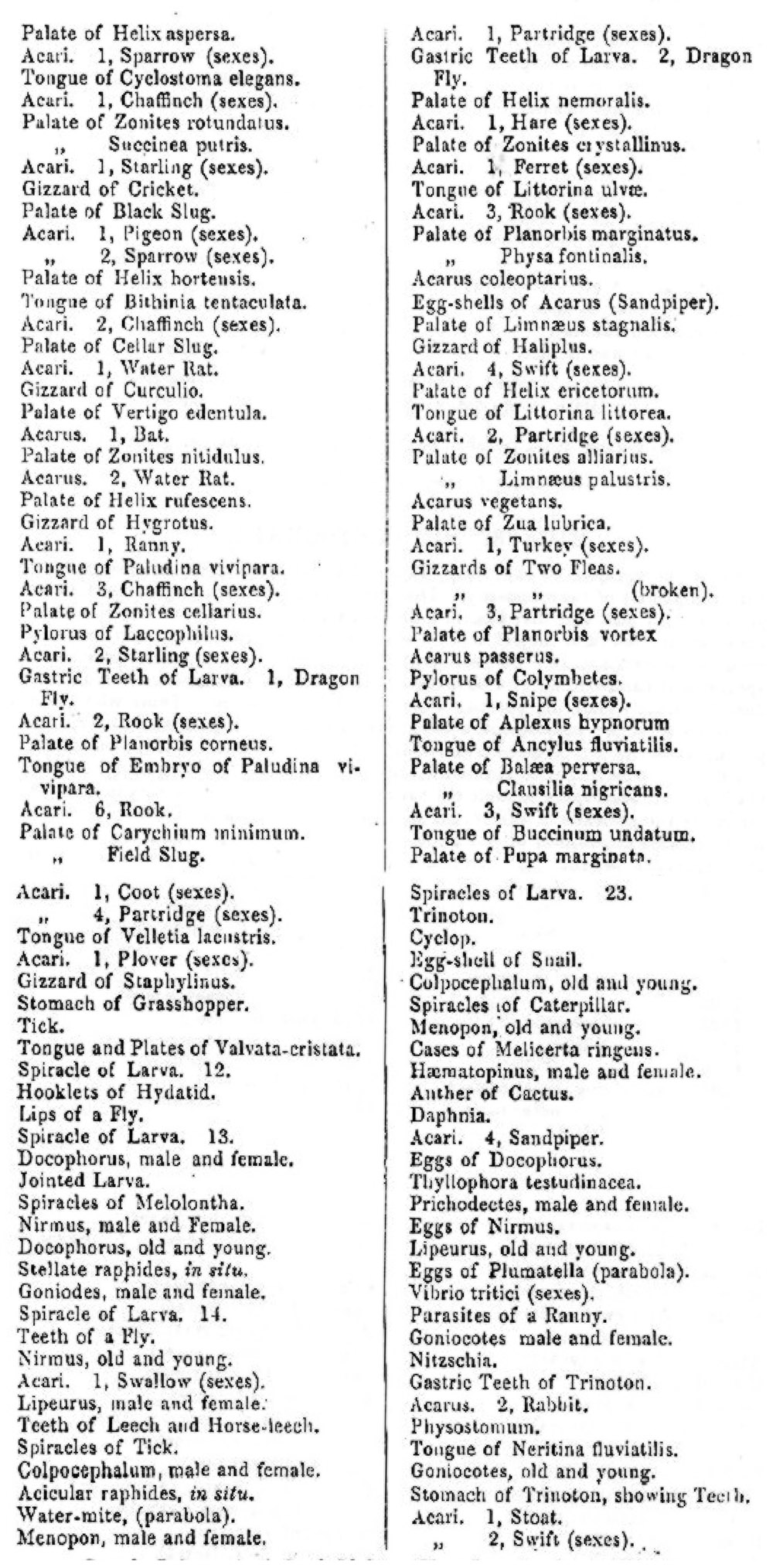
Figure 6.
List of slides offered by F. and J. Amadio in their 1864 catalog. Note that the numbers associated with slides are seemingly disordered. The description of a slide of flea gizzards as being "broken" may refer to preparations such as shown on the right of Figure 5 (above), with the specimens being "broken up to shew structure".
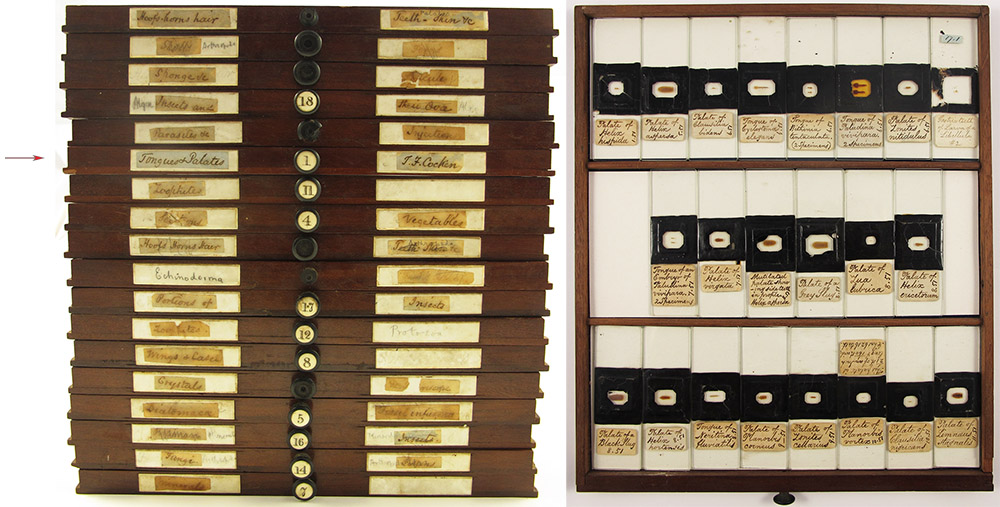
Figure 7.
(Left) fronts of drawers from a Victorian-era slide cabinet, one of which is labeled “Tongues and Palates” and “J.F. Cocken”. (Right) Slides of “tongues” and “palates” that were included in the cabinet.
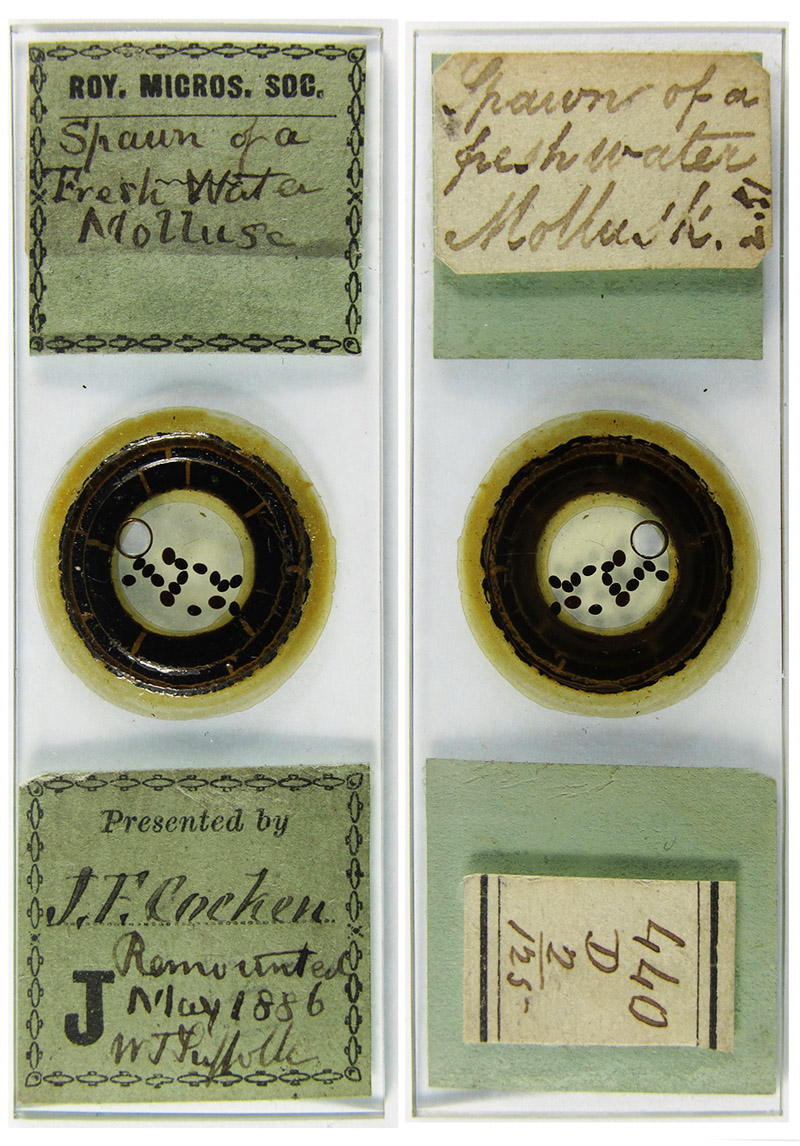
Figure 8.
Both sides of a slide that was donated to the Royal Microscopical Society by J.F. Cocken. The original label was later moved to the reverse of the slide. It was remounted in May, 1886 by W.T. Suffolk.
John Fisher Cocken was born on December 5, 1808 in the Saint Giles Cripplegate Parish of London. His father, Edmund, owned a silk business. The father died in 1833, and the business was inherited by John and his elder brother, Edmund. The 1841 census shows John (“silk manufacturer”) living at the business address, 5 Milk Street, with a maiden aunt and two servants. Brother Edmund lived with their widowed mother, another maiden aunt, and two servants in Hackney. Even though John moved to the suburbs during the 1850s, an 1880 notice of his death gave the Milk Street address, indicating that he remained involved with the family silk business.
The earliest identified record of John Cocken’s contributions to science is an 1850 donation of Cymatopleura hibernica diatoms to the British Museum. The Reverend William Smith reported in 1851 that he identified Surirella craticula diatoms “in a slide labelled ‘River Bann, Ireland’, sent me by Mr. Cocken”.
Also in 1851, Samuel Woodward published his book on mollusks that described the above-mentioned Cocken slide of a Testacella haliotides radula, Cocken’s count of the number of teeth on a Planorbi contortus radula, and Cocken’s method of mounting radulae. The 1856 edition of Woodward’s book included an additional citation of Cocken’s contributions to mollusk radula studies (Figure 9).
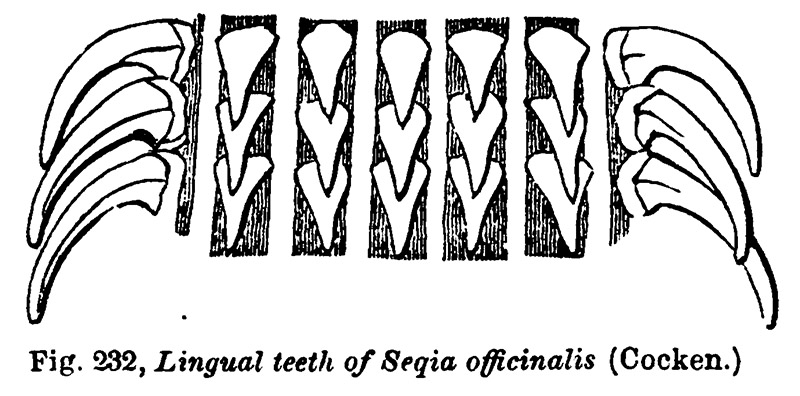
Figure 9.
Drawing of a microscopic view of the radula of a Sepia officinalis (the common cuttlefish), based on a preparation by J.F. Cocken, from S.P. Woodward’s 1856 edition of “A Manual of the Mollusca”.

Figure 10.
(left) Excerpt from Smith and Beck’s delivery books, indicating that Cocken received an “Educational” microscope with serial number 1480 on July 17, 1857. (right) An example of a Smith and Beck “Educational” model, serial number 1803.
Cocken’s whereabouts have not been identified in the 1851 census, but by 1861 and onward he lived outside of metropolitan London. The 1861 census listed him as being a “landholder”, and boarding with grocer William Street and family in Rickinghall, Suffolk. He appears to have remained with the Street family until the end of his life. The 1871 census listed him as their boarder, and being a “retired silk merchant and land owner”. The 1875 edition of the Post Office Directory of Cambridge, Norfolk and Suffolk listed John Fisher Cocken among the gentry of Rickinghall Superior. That village is adjacent to Botesdale, and Cocken variously used either as his address.
On September 27, 1878, J.F. Cocken donated “68 slides of acari” and “16 slides of shells of mollusca” to the Quekett Microscopical Club. These were particularly appreciated by the club, as noted in the minutes, “on the motion of the Chairman, a special vote of thanks was accorded to Mr. J.F. Cocken, of Botesdale, for his valuable additions to the Cabinet”. Another 24 slides of unspecified subjects were donated on June 25, 1880.
Cocken’s donations of acari slides to the Q.M.C. were further noted in T.S. Cobbold’s 1879 President’s Address, “The Club, indeed, already possesses a tolerably extensive series of external parasites, beautifully mounted on slides ; but comparatively few of them are scientifically named. The principal specimens have been contributed by Messrs. Cocken, Beaulah, Michael, Bramhall, Quick, White, Curties, Bockett, Collins, Freeman, and Green, and by Drs. Dickson, Gray, and M.C. Cooke”. In 1882, J.E. Ingpen exhibited “Bird Acari, mounted by the late Mr. J. Cocken”.
John Fisher Cocken never married. He died on September 4, 1880, in Rickinghall Superior, at the age of 72.
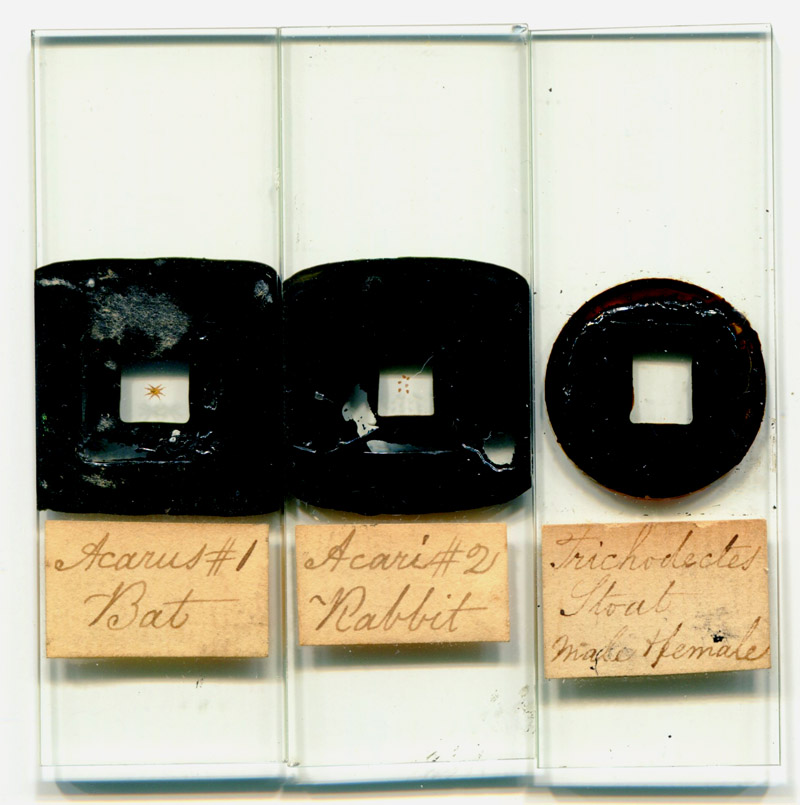
Figure 11.
Consistent with Cocken’s interest in acari from birds, large numbers of slides attributable to him contain bird mite specimens. Far less common are slides such as these, which contain acari and other parasites of mammals.
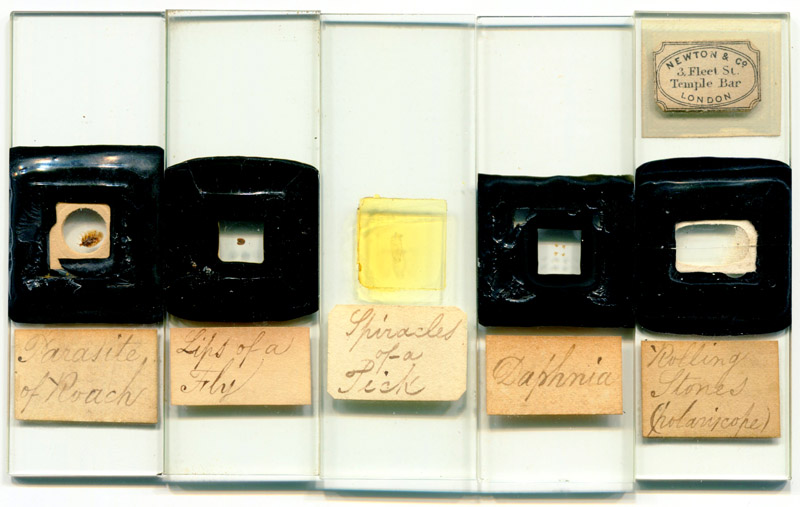
Figure 12.
Uncommon slides of other objects. The rightmost slide, “rolling stones”, contains small sand grains in fluid, designed to be shaken and the tumbling “stones” observed through crossed polarizing filters. This type of slide was purely for amusement.

Figure 13.
Some relabeled preparations.
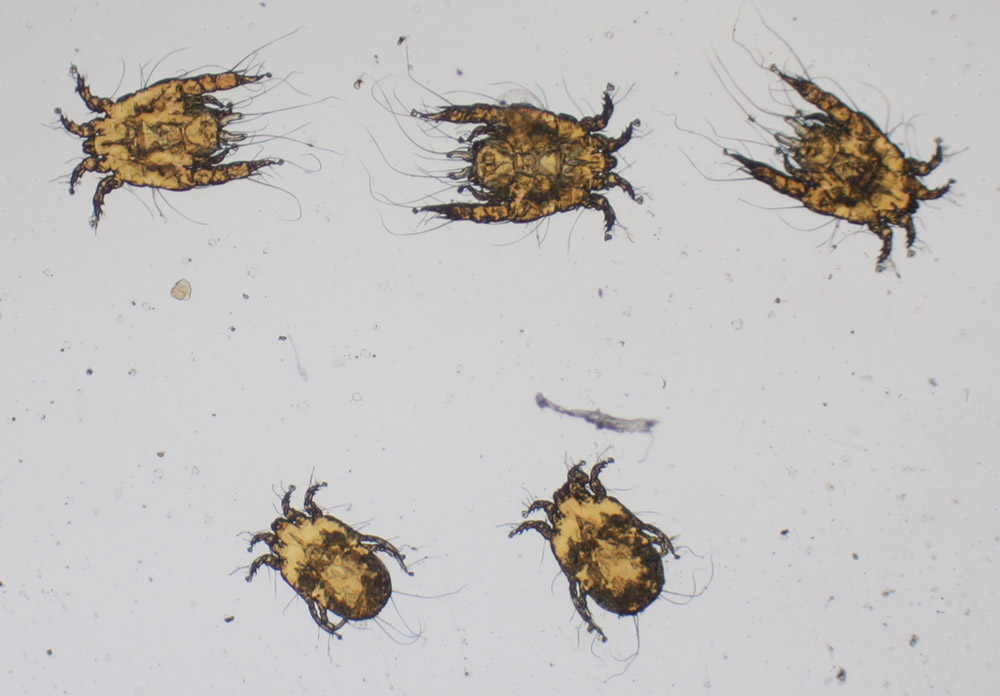
Figure 14.
Acari of Linnet, three males (top) and 2 females (bottom). From a slide shown in Figure 3.
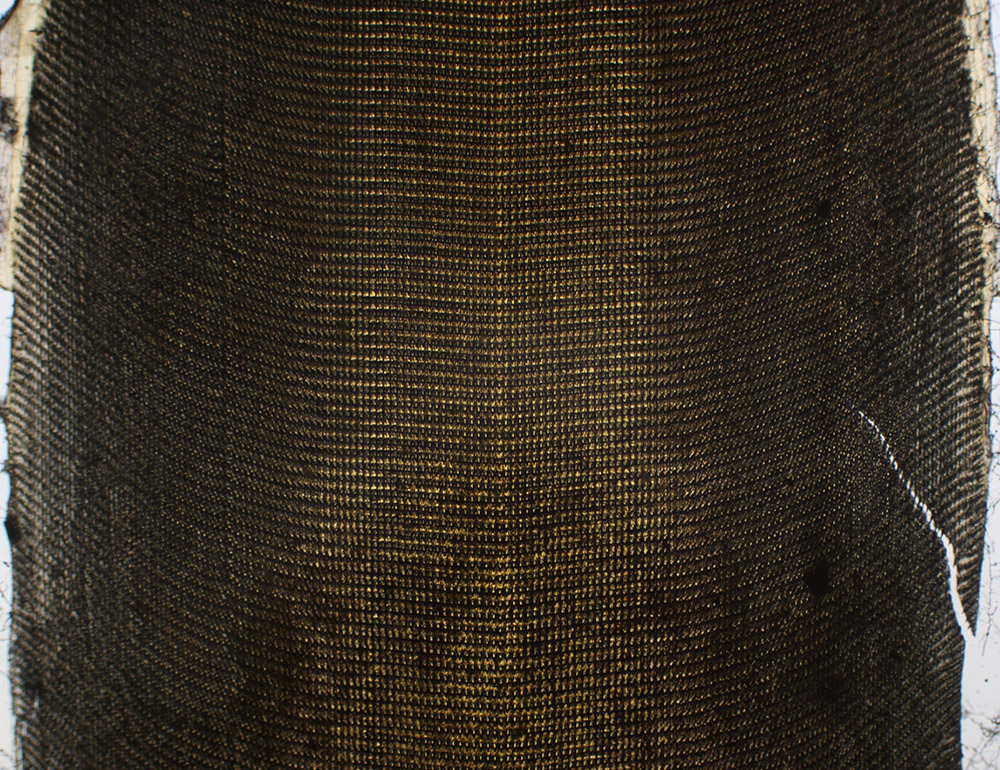
Figure 15.
Palate of a cellar slug, from a slide shown in Figure 2.
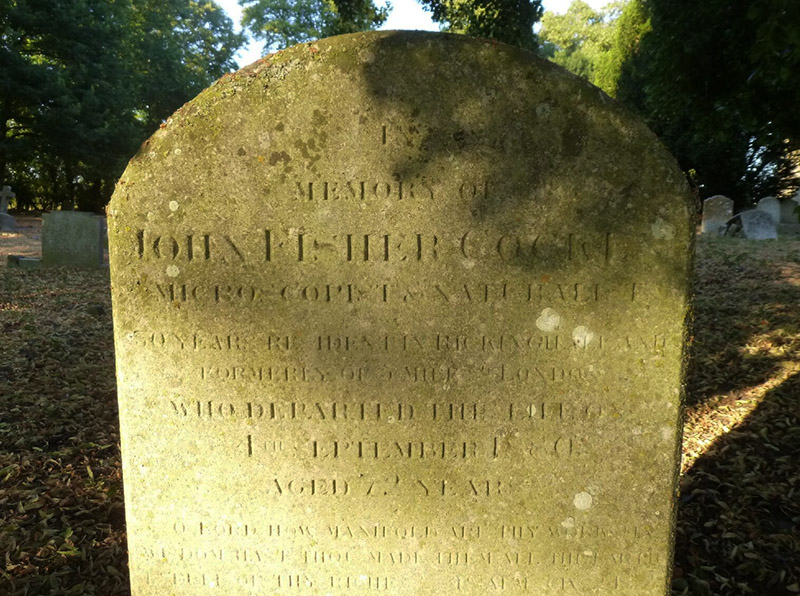
Figure 16.
John Cocken’s gravestone, in the Rickinghall cemetary. It reads "In memory of John Fisher Cocken, Microscopist & Naturalist, 30 Years resident in Rickinghall and Formerly of Milk St London, Who departed this life on 4th September 1880. O Lord, How manifold are thy works. In Wisdom hast thou made them all; the Earth is full of thy riches. Psalm CIV 24". Photograph courtesy of Sarah Doig and Richard Courtiour.
Acknowledgments
Thank you to Richard Courtiour for providing pictures of his slide cabinet and for initiating this research, to Peter Hodds for sharing images and helpful ideas, to Sarah Doig for the photograph of John Cocken’s gravestone, and to Howard Lynk for sharing his thoughts on this and other microscopical topics.
Resources
Amadio, Francis and Joseph Amadio (1864) A Catalogue of Achromatic Microscopes and other Optical, Philosophical, and Mathematical Instruments, Manufactured and Sold by F. & J. Amadio, Opticians to the Admiralty, 7, Throgmorton Street, London
Cobbold, T. Spencer (1879) Inaugural Address of the President, The Journal of the Quekett Microscopical Club, Vol. 6
England census and other records, accessed through ancestry.com
Gray, John E. (1852) On the Teeth on the Tongues of Mollusca, The Annals and Magazine of Natural History, Series 2, Vol. 10, pages 411-417
Gray, John E. (1853) On the teeth of the pneumonobranchiate mollusca, The Annals and Magazine of Natural History, Series 2, Vol. 12, pages 329-333
Gray, John E. (1853) Teeth of Testacellus and Glandina, The Annals and Magazine of Natural History, Series 2, Vol. 12, page 478
Gray, John E. (1853) On the Teeth on the Tongues of Mollusca, Journal of Microscopical Science, 1853, pages 170-176
Gray, John E. (1857) Manual of the Land and Fresh-Water Shells of the British Islands, Longman, Brown, Green, Longmans, and Roberts, London
The Journal of the Quekett Microscopical Club (1878) Minutes of the September 27 Ordinary Meeting, Vol. 5, page 137
The Journal of the Quekett Microscopical Club (1880) Minutes of the June 25 Ordinary Meeting, Vol. 6, pages 182-183
The Journal of the Quekett Microscopical Club (1881) Minutes of the April 29 Special Exhibition Meeting, Vol. 6, pages 315-318
The Journal of the Quekett Microscopical Club (1882) Minutes of the March 31 Special Exhibition Meeting, Series 2, Vol. 1, pages 131-132
Legg, M.S. (1853) Observations on the examination of sponge sand, with remarks on collecting, mounting, and viewing foraminifera as microscopic objects, Quarterly Journal of Microscopical Science, Vol. 2, pages 19-22
Michaels, A.D. (1894) The President’s Address: The progress and present state of our knowledge of the Acari, Journal of the Royal Microscopical Society, pages 18-33
The Natural History Review (1865) Obituary of Samuel P. Woodward, Vol. 5, pages 579-580
Observations of the Suffolk Naturalists' Society (undated, accessed July, 2018 through https://issuu.com/suffolknaturalistssociety/docs/tsns3_1_l) A forgotten Suffolk naturalist, page 99
Post Office Directory of Cambridge, Norfolk and Suffolk (1875) Rickinghall Superior, page 901
Probate of the will of John Fisher Cocken (1880) “The Will with a Codicil of John Fisher Cocken late of Rickinghall Superior in the County of Suffolk Esquire who died 4 September 1880 at Rickinghall Superior was proved at Bury St. Edmunds by Isabella Gray of Denbigh House Ryde in the Isle of Wight Widow the Sister the sole Executrix. Personal Estate under £12,000”, accessed through ancestry.com
Smith and Beck Delivery Books (accessed July, 2018) http://littleimp.quekett.org/Beck1/pg47.htm
Smith, William (1851) Notes on the Diatomaceae; with descriptions of British species included in the genera Campylodiscus, Surirella and Cymatopleura, The Annals and Magazine of Natural History, Series 2, Vol. 7, page 13
Smith, William (1859) List of British Diatomaceæ in the Collection of the British Museum, Trustees of the British Museum, London, page 14
Taylor, John (1907) Monograph of the Land & Freshwater Mollusca of the British Isles, Vol. 2, Parts 8-13, Taylor brothers, Leeds, page 23
Thetford & Watton Times and People's Weekly Journal (1880) Deaths: “Suffolk, aged 72. John Fisher Cocken, formerly of 5, Milk Street, London”, September 11
Walker, David (accessed May, 2014) A "palette of palates": exploring a selection of prepared slides of snail radulas - a classic type of Victorian microscope slide, http://www.microscopy-uk.org.uk/mag/artmar10/dw-palate.html
Woodward, Samuel P. (1851) A Manual of the Mollusca, John Weale, London, pages 169, 172, and 460-461
Woodward, Samuel P. (1856) A Manual of the Mollusca, John Weale, London, pages 169, 172, 448, and 461















